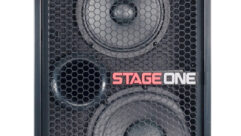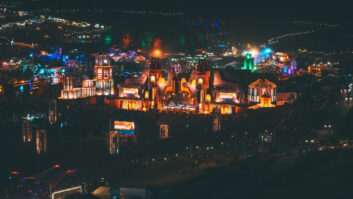Music for the masses
May 20, 1997 12:00 PM,
Biff McGillicutty
The sound, video and lighting systems are all essential to the Ministry of Sound’s mission of entertaining the club-going public.In a country where an artist can be a complete unknown at 9:00 a.m., number one on the pop chart by 7:00 p.m. and yesterday’s news before the following day begins, people take releasing music to the masses very seriously. Now, that timeframe may be slightly exaggerated, but it does emphasize the importance in England of getting new music into the ears of eager CD purchasers.
Superclubs are a large part of this culture. They are seen as the trendsetters for the creation of new music superstars in the UK and where the all important hype begins for other important world markets.
The Ministry of Sound, London’s world renowned nightclub, is certainly no exception in the trendsetter department. The often emulated multiroom, large-scale super club recently underwent a major overhaul of its main room, furthering the Ministry’s worldwide status as a benchmark in the entertainment industry. The main room is the focal point and showcase venue for breaking new music of many different genres from around the world. It is not a place to simply experience what you hear on the radio.
According to Nodd McDonagh, General Manager of the Ministry of Sound, “There is a great pressure here in the UK to continue raising the standards by which we are measured. For the last number of years we’ve had a reputation of being one of the world’s best at presenting and delivering new and innovative music to the club-going public. The Ministry of Sound extends beyond the boundaries of the club itself into record sales, merchandising and other things. This profile is a major reason why our sound is taken so seriously. Our intention for the redesign was twofold, first to keep the benchmark moving up in regard to new players in our market and, most important, we felt there were areas here that we could certainly upgrade and improve upon.”
Reasonable expectationsBecause of the nature of the nightclub business, the sound system had been pushed beyond reasonable limits. The result, combined with incorrect drivers in some boxes, was component failures that were beginning to become a problem.
“When we decided to move forward with the new project, it was apparent that our system was wrapped in such cloaks of mystery it was difficult for us to determine what was legend and what was fact about it,” says McDonagh. “Between our technical audio team, headed by Santiago Arribas, and Austen Derek of GSA New York, the firm that had designed and installed the original system, we set a course to improve the overall audio quality and reliability of the system.”
The first step was to have GSA fly to London and write a report on the status of the system. The goal was to get to the root of the existing problems and make recommendations for the necessary improvements. These recommendations were devised as a result of GSA’s designers spending time listening and taking many measurements and, most important, as a result of GSA serving as the designer and installer of the original system. That experience gave GSA an added insight into what had occurred in the five years since the first installation.
“The original system consisted of proprietary boxes designed by Richard Long,” says Austen Derek of GSA. “A couple of very apparent problems were that, over the years of operating the system, components had been replaced that weren’t ideally suited to the enclosures and therefore didn’t work well in them. Changes in the physical placement of the loudspeakers were another issue of concern; the amount of cancellation in the room was substantial. The amp room wasn’t ideal, and the first system used a horn design that at the extreme sound pressure levels (in excess of 150 dB peak at times) the club works to, the resulting mid-high and high-frequency sound was very shrill and harsh.”
The approach chosen by GSA and Ministry management to achieve the desired result of high fidelity — extreme SPL — was to minimize downtime while making use of existing hardware that was not part of the problem. This meant not only making required hardware changes but making fundamental changes to equipment organization, maintenance and the implementation of damage prevention protocol.
Improving and expandingBoth the DJ booth and the amp rack room were subject to an inordinate amount of patron traffic, resulting in the air conditioning controls being inadvertently switched on and off and in general system abuse. The amplifiers in the amp room were also stacked fairly close to the ceiling, causing extreme heat. These two factors combined to create an environment that made the amplifiers work much harder than required to do the job. The recommendations included isolating the amp room and installing a proper ventilation and humidity control system to ensure that the equipment was able to perform at a top-notch level.
In addition, the system controls were located in a limited-access area. The considerable distance from the console controls to the system controls made it extremely inconvenient and time consuming for set up, reconfiguration or merely making a thorough check of the sound system. The remedy for this problem was to build an overhead console to house all of the processing equipment and necessary outboard gear. By placing required components at arms reach, time, energy and money would be saved from the system operation and general maintenance standpoint.
A musical soundMaximizing the output capacity and fidelity of the existing cabinets was the next order of business. The first step in this area was to seriously upgrade the power. Three Crest 9001 amplifiers were installed to replace the existing power. The introduction of the 9001 amps gave the system considerably more headroom and punch. The loudspeaker cable runs were still intact and were kept in place, although the termination points at the loudspeaker end and front end were upgraded whether the component was changed out or not.
With power and cabling looked after, next came the sub-bass cabinets, six RLA Levens. These were upgraded by adding JBL 2241 drive units. GSA had experience with these particular drivers and knew that they were an appropriate performance match to the cabinet. The main bass consisted of six RLA Puissance cabinets. The 15 inch Electro-Voice 150A was the driver of choice, mainly because of its huge power rating of 1,000 W continuous program. This specification helped meet the requirements for increasing overall system reliability.
The low-mid section of the system consists of six RLA Double D cabinets. Before the upgrade, JBL E 120s were being used. This drive unit is more compatible with a tuned direct radiated enclosure, and the RLA is a horn-loaded enclosure. With this in mind, GSA recommended the JBL 2206 driver as a replacement to create a smoother transition from the low-mid into the mid-high section.
The mid-high section was the area of greatest concern. The mid-high performance was very shrill and not up to today’s standards of fidelity. GSA and the Ministry chose to enlist the assistance of Martin Audio of London to redesign the mid-high section of the loudspeakers. The reason for choosing Martin was GSA’s experience with its own stock of 32 Martin W8 and W8S loudspeakers and, in particular, the units’ mid-high performance.
“The sound system when originally installed was quite astounding for its time,” says Gary Stewart of GSA. “The upgrade and addition of the Martin W8 mid-high section delivers the high-tech solution, maintaining the cachet that Ministry of Sound has come to exemplify.”
According to Bill Webb, director of engineering for Martin Audio, “Eliminating the harshness associated with the large-format, 2 inch (51 mm) exit compression driver is essentially what the top end of the Martin Wavefront 8 does for Ministry. Delivering fidelity and purity at exceptional sound pressure levels is a direct result of replacing the 2 inch with a 6.5 inch (165 mm), specially treated cone driver leading into a 1 inch (25 mm) compression exit driver at 3.5 kHz. In essence, distortion from the 2 inch is removed by utilizing a much larger diaphragm with a lower compression ratio. The larger area doesn’t allow the air overload in the throat of the horn that caused the distortion in the first place. This allows the main vocal range to be reproduced with a more natural and transparent response where the human ear is most sensitive. Even at the massive sound pressure levels common to Ministry.
“To cover the surface area in a facility as large as the Ministry of Sound, frequency response both on and off axis has to be smoothly maintained. The toroidal phase plug employed in conjunction with the 6.5 inch cone provides very proficient constant directivity characteristics, producing even coverage without beaming. The club is on a one-to-one ratio — two 18 inch (457 mm), two 15 inch (381 mm), two 12 inch (305 mm) — so we designed a double horn module that in effect is the W8 mid-high section times two. This solution completed the coverage, sound pressure level requirements and reliability that GSA and Ministry set out to accomplish.”
A resounding successWith all necessary components replaced and rewired, the next step was to tweak all the outboard gear and measure the results. The BSS Omnidrive remained the focal point of the system control section in combination with the BSS FCS 926 Varicurve. Three new BSS pieces were added for the ultimate control setup: the FCS 960 graphic equalizer, DPR 402 compressor for the tweeter array and the DPR 901 expander placed in the mixer loop.
After the final system configuration and equalization was complete, Nodd McDonagh of Ministry said, “The installation is a resounding success. On the first two nights after the install, the crowd demanded the DJ play an extra hour. I’m amazed at the quality and depth of the system, in particular the Martin horns. The fidelity is great sounding and not fatiguing as the previous system was.”
The room, at 65% output, registered a flat 152.6 dB. The A-weighted measurement was 142 dB peak. The measurements were made using an Ivie IE30P spectrum analyzer with an Ivie random response capsule.
The overall result of the audio upgrade to Ministry is exactly what they had envisioned. Through careful planning, Ministry and GSA were able to accomplish their goal of a high output, high fidelity system that keeps Ministry well above the competition in the super club marketplace. The standards have again been raised worldwide by the Ministry of Sound’s commitment to audio excellence.
With the emphasis at Ministry being on all things new, hip and exciting, the video and lighting effects are rotated or completely changed out on roughly a three-month schedule. The Ministry has extensive lighting stock in house to make frequent changes.
The focus of the lighting design is the creation of moods and tones congruent with the season or festive events on the calendar. The main themes are created using a variety of mainly Clay Paky lights fed through a Pulsar control system and par cans. To enhance the desired environment created by both the music and lighting, other interesting tools are used. The computer controlled video system allows pre-programmed material to be combined with live video footage from the Sony V600 Hi-8 camera and projected on various surfaces throughout the main room. This creates effects such as placing the head of an audience member on the top of a computer generated entity and making him appear to be doing silly things. In general the system allows a large amount of flexibility in creating images that involve patrons of the club, helping to maintain attention and keep people interested in coming back.
Until recently the Ministry had also been known for elaborate theatrical-type set designs adorning the main room. Lately James Donaghy, video and lighting director for the club, has made a concerted move toward more abstract, lighting based creations. For instance, a local artist has created a light interactive piece using a collection of abstract objects covered with a combination of conventional and ultraviolet light-reactive paints. A masked Sanyo LCD video projector beams both video images and straight light onto the piece, creating an everchanging piece of artwork.
The main room on any night is an excellent experience. The video and lighting staff are given a great deal of creative latitude to maximize the system. Combined with the upgrade in audio, the video and lighting system results in something spectacular on a world-class scale.
Video equipment list
1 Sanyo PCC220PB LCD video projector (1,000 lumen)
1 Panasonic WJ AVE5 Vision Mixer
2 JVC HRJ jog/shuttles
1 Sony V600 Hi-8 video camera
Lighting equipment list
2 Clay Paky Golden Scan H.P.E.s
4 Clay Paky Super Scan MRGs
4 Clay Paky Golden Scan 3s
4 Clay Paky Combi Color 300s
24 Par 64s
3 Pulsar Masterpiece 108 controllers
1 Pulsar Masterpiece replay unit










